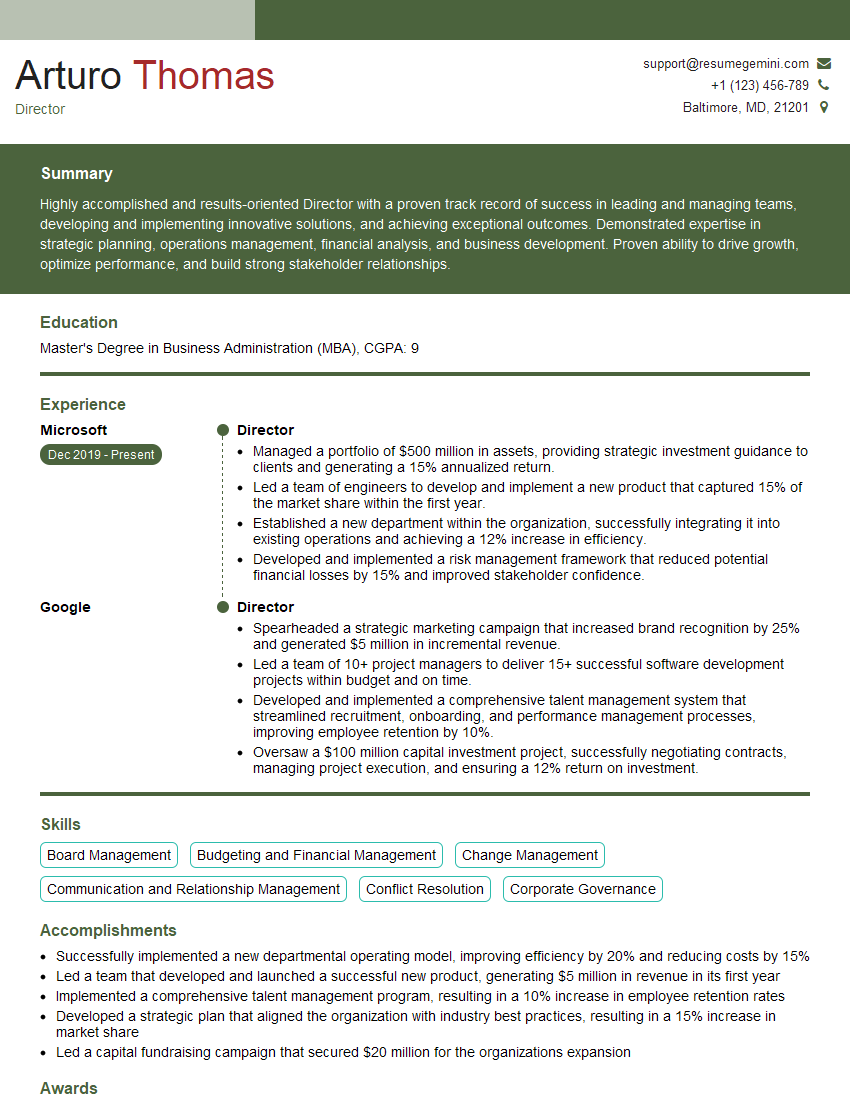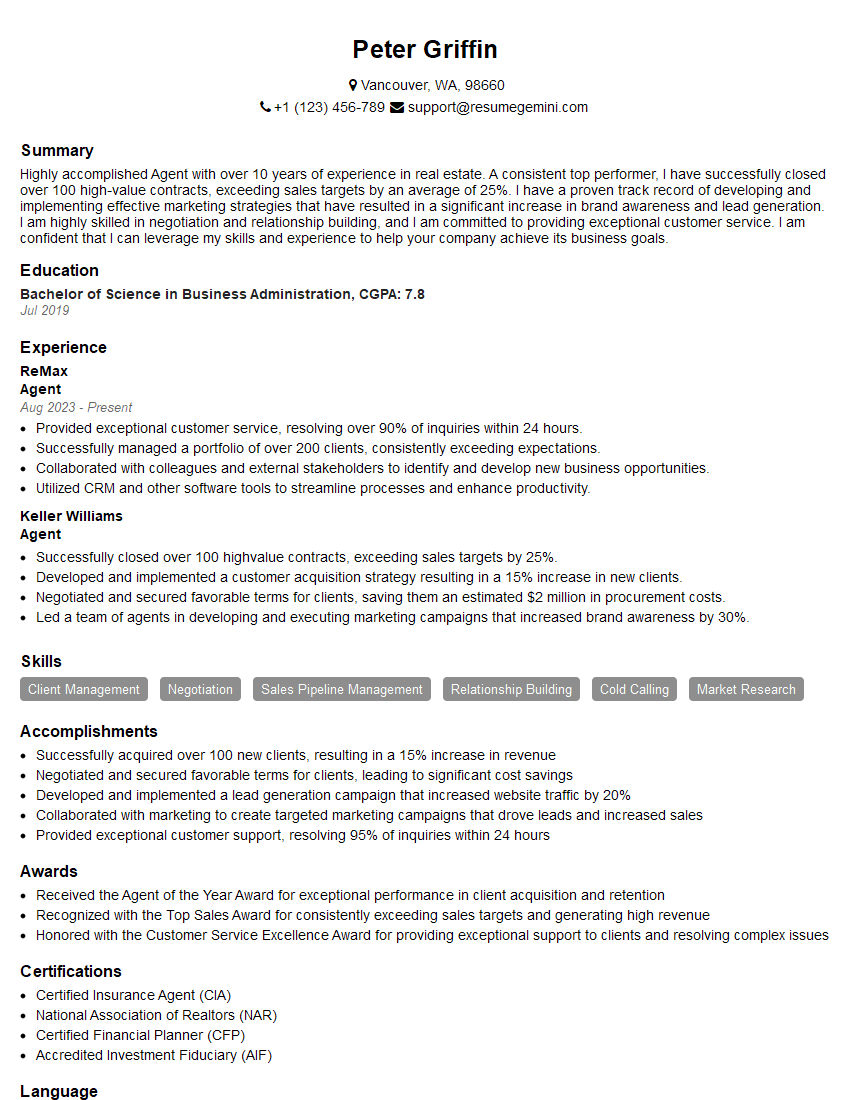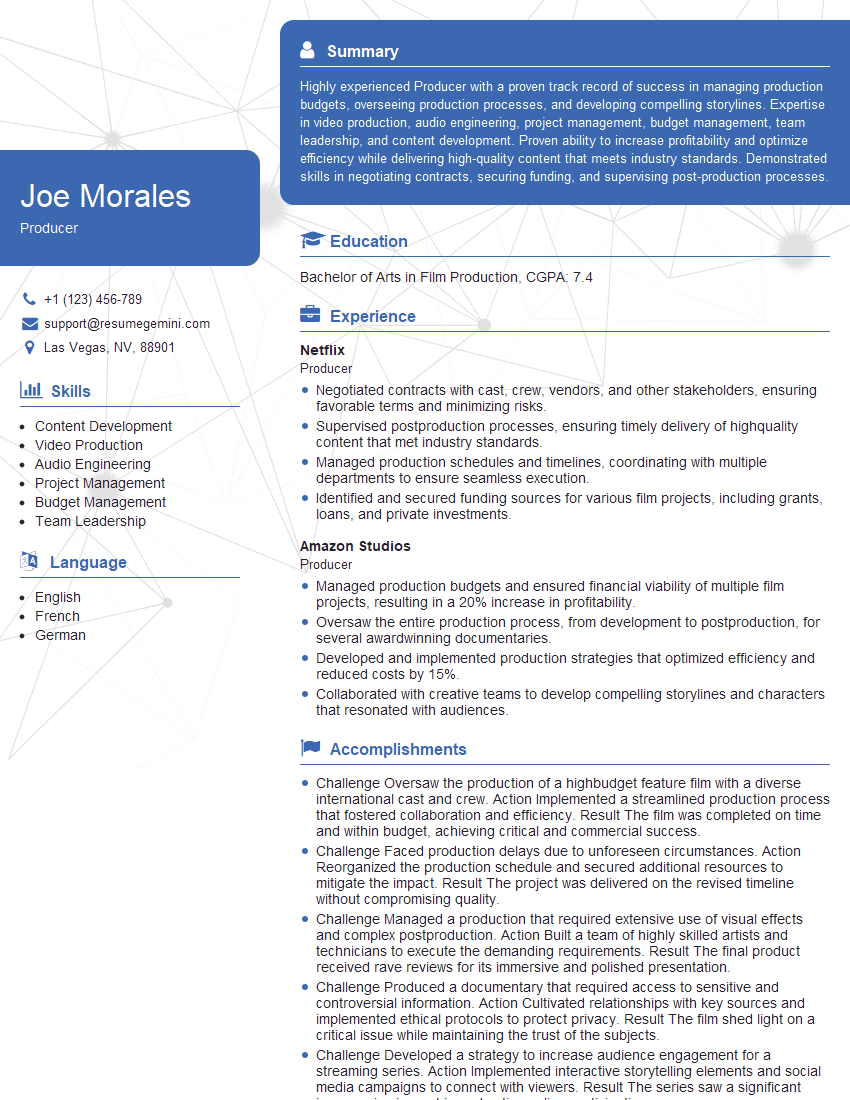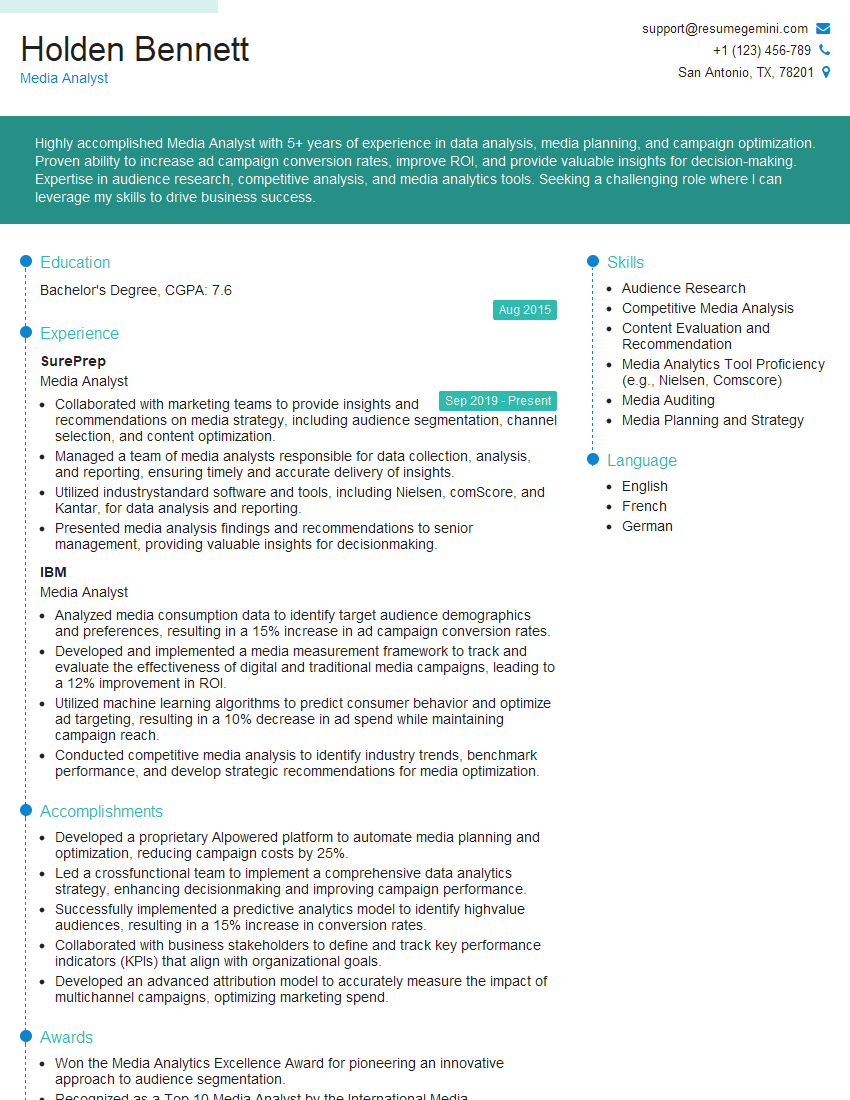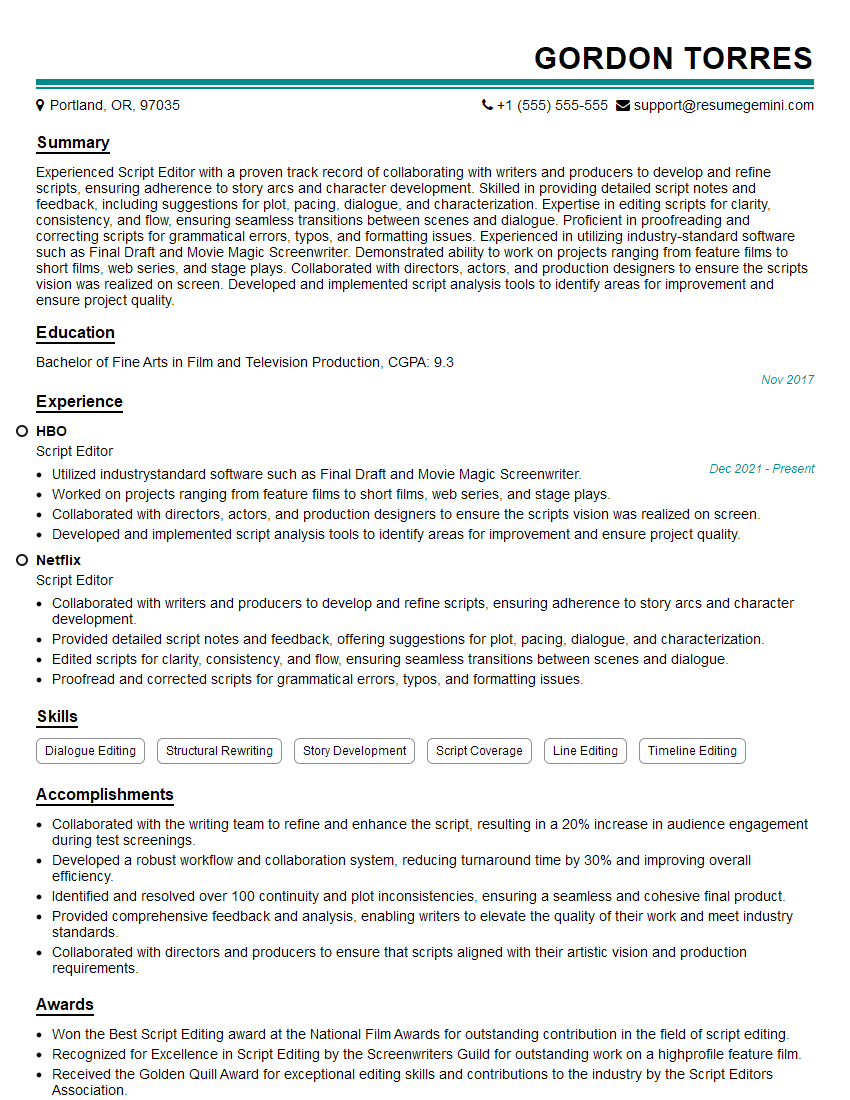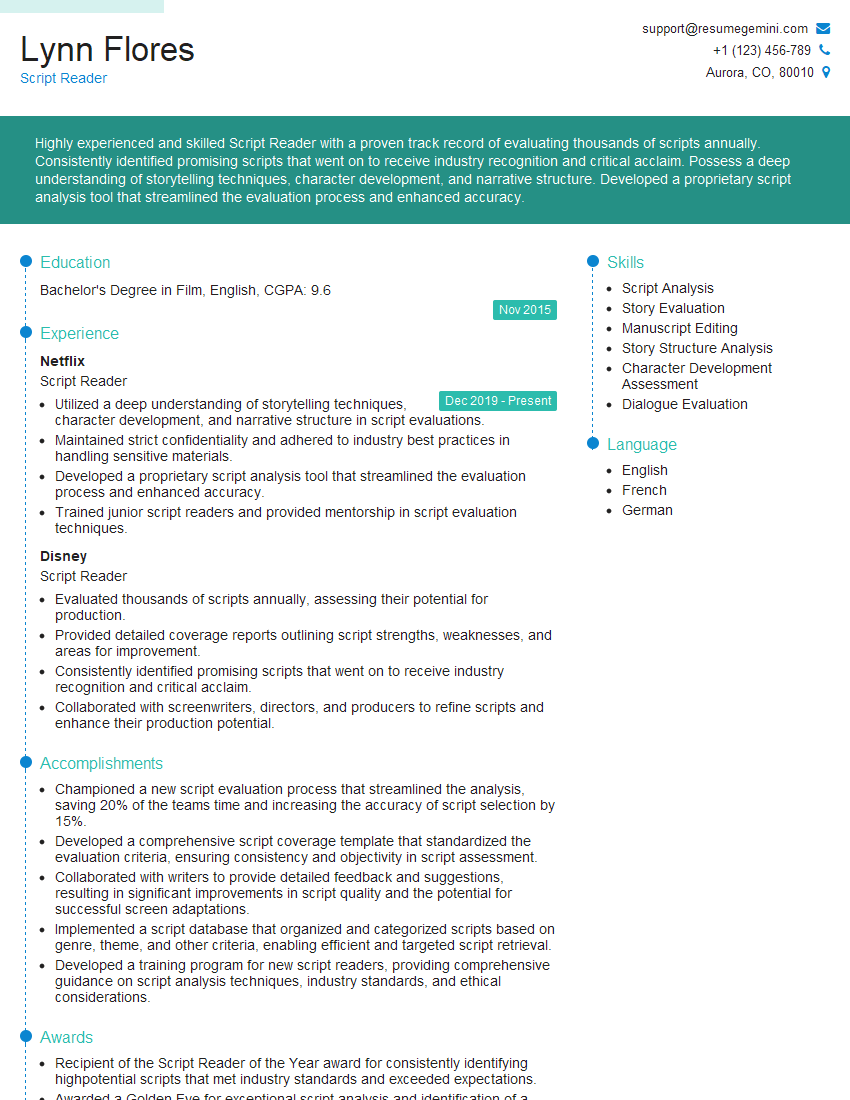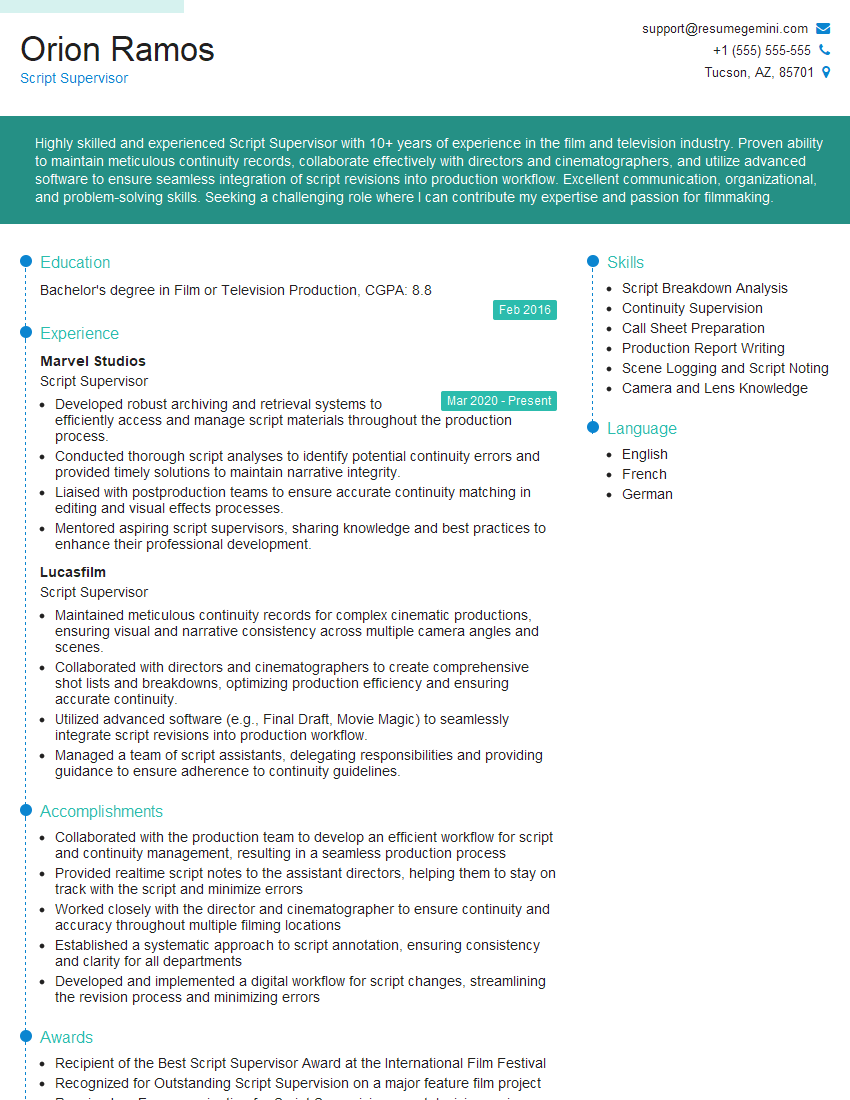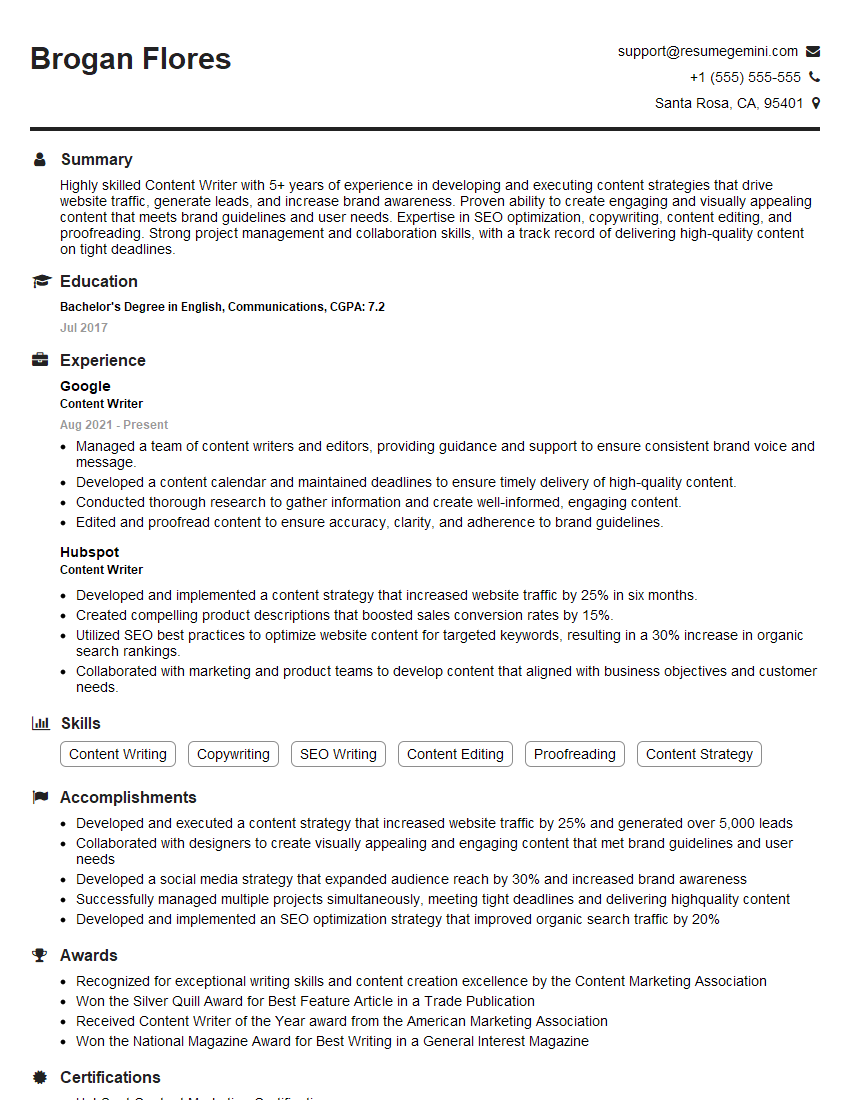Every successful interview starts with knowing what to expect. In this blog, we’ll take you through the top Script Analysis and Interpretation interview questions, breaking them down with expert tips to help you deliver impactful answers. Step into your next interview fully prepared and ready to succeed.
Questions Asked in Script Analysis and Interpretation Interview
Q 1. Explain the three-act structure and its application in script analysis.
The three-act structure is a fundamental framework in storytelling, dividing a narrative into three distinct sections: Setup, Confrontation, and Resolution. In script analysis, understanding this structure helps us analyze the plot’s progression, character development, and thematic resonance.
- Setup (Act I): This introduces the protagonist, their world, and the central conflict. We learn about their goals, motivations, and the stakes involved. Think of it as laying the foundation for the story. A classic example is the first act of Star Wars: A New Hope, where we meet Luke Skywalker, learn about his mundane life, and are introduced to the overarching conflict between the Rebel Alliance and the Empire.
- Confrontation (Act II): This is where the protagonist actively engages with the central conflict, facing obstacles and challenges that escalate the tension. This act often involves a series of setbacks and triumphs, building towards a major turning point or climax. The Lord of the Rings: The Fellowship of the Ring‘s second act perfectly exemplifies this, showcasing the fellowship’s journey and the escalating threats they face.
- Resolution (Act III): The final act brings the story to its conclusion. The central conflict is resolved, often through a climactic confrontation. Loose ends are tied up, and the consequences of the events are explored. The final battle in The Hunger Games is a prime example of a powerful and conclusive Act III.
Applying this structure in analysis allows us to assess the effectiveness of the pacing, the logical progression of events, and the overall coherence of the narrative. We can identify potential weaknesses – for instance, a weak setup that doesn’t adequately establish the conflict or a resolution that feels unearned.
Q 2. How do you identify narrative inconsistencies within a script?
Identifying narrative inconsistencies is crucial for a thorough script analysis. It involves carefully examining the script for contradictions, plot holes, and illogical leaps in the story. I usually employ a systematic approach:
- Chronological Read-Through: I start with a thorough read-through, paying close attention to the timeline and the sequence of events. Any discrepancies or jumps in time that don’t make logical sense are flagged.
- Character Consistency Check: I analyze character motivations and actions, looking for any inconsistencies in their behavior. Does a character’s action align with their established personality and goals? A sudden shift in personality without sufficient explanation is a red flag.
- Plot Point Analysis: I examine each major plot point, ensuring that it logically follows from previous events and contributes to the overall narrative. Are there any unresolved plot threads or unexplained elements?
- World-Building Consistency: For scripts with established worlds, I examine the internal consistency of the setting, rules, and established lore. Are there any contradictions in the rules governing the fictional world?
For example, if a character is described as having a particular phobia in one scene but acts without fear in a later scene, this is a significant inconsistency. Similarly, a plot point that seemingly appears out of nowhere without proper setup would be a narrative weakness.
Q 3. Describe your process for analyzing character arcs.
Analyzing character arcs involves tracing a character’s transformation throughout the narrative. It’s about understanding their journey of growth, change, or decline. My process involves:
- Identifying the Initial State: I begin by defining the character’s initial personality traits, motivations, and goals at the beginning of the script.
- Pinpointing Key Turning Points: I then identify pivotal moments in the story that significantly impact the character. These are often moments of conflict, revelation, or significant decision-making.
- Tracing the Transformation: I track how the character changes in response to these turning points. Does their personality evolve? Do their goals shift? Do they learn or grow as a person?
- Assessing the Arc’s Completeness: Finally, I evaluate the arc’s effectiveness. Does the transformation feel organic and believable? Does the ending reflect the character’s journey?
For instance, in The Wizard of Oz, Dorothy’s arc is about her journey from a naive girl longing for home to a confident young woman who appreciates her own home and community. Analyzing her interactions with other characters and the challenges she overcomes helps us understand her growth.
Q 4. What are the key elements of a compelling screenplay?
A compelling screenplay possesses several key elements:
- Compelling Premise: A strong and engaging central idea that immediately grabs the reader’s attention.
- Relatable Characters: Characters with clear motivations, flaws, and strengths that resonate with the audience, even if they are not necessarily likeable.
- High Stakes: A significant level of risk or potential loss to keep the audience invested in the outcome.
- Strong Plot Structure: A well-defined beginning, middle, and end with a clear progression of events and logical cause-and-effect relationships.
- Thought-Provoking Themes: Underlying messages or ideas that explore universal human experiences and resonate with the audience on an emotional level.
- Dialogue that Reveals Character: Conversations that propel the plot forward, advance character development, and reveal subtext.
- Visual Storytelling: The screenplay effectively uses visuals to enhance the narrative, creating vivid imagery in the reader’s mind.
The combination of these elements creates a cohesive and engaging experience for the audience, leaving them satisfied and possibly even pondering the themes long after the credits roll.
Q 5. How do you assess the pacing and rhythm of a script?
Assessing pacing and rhythm involves analyzing the flow of information and the emotional impact on the audience. It’s about the balance between action, dialogue, and exposition.
- Scene Length and Transitions: I look at the length of each scene and the transitions between them. Are some scenes too long or too short? Are the transitions smooth and logical or jarring and abrupt?
- Tempo Changes: I note how the tempo changes throughout the script. Are there moments of high tension followed by periods of calm? Does the pacing build effectively toward the climax?
- Inciting Incidents and Plot Points: The placement of important plot points and inciting incidents significantly influence pacing. Are they spaced out effectively or clustered together, disrupting the flow?
- Reader Engagement: I consider how the pacing affects reader engagement. Does the script keep the reader engaged throughout or are there sections that feel slow or rushed?
A well-paced script uses a dynamic rhythm, alternating between moments of high tension and quieter, more reflective scenes. A poorly paced script might feel sluggish or rushed, making it difficult for the audience to connect with the story.
Q 6. What techniques do you use to analyze subtext in dialogue?
Analyzing subtext in dialogue goes beyond the literal meaning of the words spoken. It’s about understanding the unspoken intentions, emotions, and motivations behind the characters’ communication.
- Contextual Clues: I examine the context of the conversation, including the characters’ relationships, their history, and the overall situation. This provides clues to what might be unsaid.
- Body Language and Actions: I consider any accompanying actions or body language described in the script. These non-verbal cues can often reveal hidden meanings or emotions.
- Contradictions: I look for contradictions between what a character says and what their actions or tone suggest. This often points to subtext.
- Silence and Pauses: Silence or pauses in dialogue can be very revealing. They often carry more weight than the words themselves.
For example, a character saying “It’s fine” in a flat tone while visibly upset reveals a significant amount of subtext. Their words are dismissive, but their actions are telling a different story.
Q 7. How would you identify a script’s target audience?
Identifying a script’s target audience requires a multifaceted approach that considers several factors:
- Themes and Content: The themes explored and the type of content will indicate who the story would most likely resonate with. A script dealing with teenage angst will clearly target a younger demographic.
- Genre and Tone: The genre (e.g., comedy, horror, drama) and tone (e.g., lighthearted, dark, serious) help narrow down the potential audience. A dark comedy likely targets a more mature audience.
- Character Archetypes: The types of characters depicted and their relationships can provide insights into the intended audience. A story focusing on corporate executives will appeal to an older, professional audience.
- Language and Dialogue: The level of language used in the dialogue and the vocabulary employed can indicate the education level and cultural background of the target audience. A script using complex language will appeal to more educated viewers.
- Marketing and Distribution: While not inherent to the script itself, how the film is marketed and distributed also indicates the intended audience.
By considering these aspects, we can develop a comprehensive understanding of who the script is intended for. This understanding is vital for both creative and marketing decisions.
Q 8. Explain the difference between plot and story.
While often used interchangeably, “plot” and “story” are distinct narrative elements. Think of the story as the chronological sequence of events as they happened, a raw account of what occurred. The plot, however, is the author’s *selection* and *arrangement* of those events to create a specific effect on the audience. It’s the story’s architecture, emphasizing causality, conflict, and suspense.
For example, the story of a man robbing a bank might include details of his childhood, his motivations, and his life after the crime. The plot, however, would likely focus on the planning of the robbery, the heist itself, and the subsequent chase and capture, omitting less relevant details to build tension and dramatic impact.
Q 9. How do you evaluate the effectiveness of a script’s exposition?
Effective exposition seamlessly integrates necessary background information into the narrative without disrupting the flow or feeling forced. We evaluate it by considering several factors:
- Brevity: Is the exposition concise and to the point? Avoid info-dumps.
- Integration: Is the information revealed organically through dialogue, action, or character interactions, rather than through lengthy explanations?
- Relevance: Is all the information crucial to understanding the plot and characters? Avoid unnecessary details.
- Engagement: Does the exposition draw the reader/viewer in, or does it feel like a tedious lecture? Effective exposition should pique interest rather than bore.
A poorly written exposition might consist of lengthy character descriptions or extensive backstories presented all at once. A well-crafted one, on the other hand, might subtly reveal character details through their actions and dialogue, letting the audience piece together the story gradually.
Q 10. What are the common pitfalls to watch out for when analyzing screenplays?
Analyzing screenplays involves several potential pitfalls:
- Ignoring Subtext: Focusing solely on the literal meaning of dialogue and actions without considering the underlying emotional currents and unspoken intentions.
- Overlooking Character Development: Failing to analyze how characters evolve, learn, and change over the course of the story.
- Misinterpreting Symbolism: Incorrectly interpreting or ignoring symbolic elements that contribute to the script’s meaning.
- Judging Based on Personal Preference: Letting personal bias about genre, style, or themes cloud objective analysis.
- Ignoring the Target Audience: Failing to consider how the screenplay might resonate with its intended audience.
For instance, misinterpreting a character’s seemingly minor action without considering their background could lead to an incomplete understanding of their motivations and the overall narrative.
Q 11. How do you differentiate between various narrative voices (e.g., first-person, third-person omniscient)?
Narrative voice refers to the perspective from which the story is told. The key difference lies in the narrator’s access to characters’ thoughts and feelings.
- First-person: The narrator is a character within the story, using “I” and sharing only their own experiences and perceptions. (e.g., The Hunger Games)
- Third-person limited: The narrator focuses on a single character’s perspective, revealing their thoughts and feelings but not those of others. (e.g., many contemporary novels)
- Third-person omniscient: The narrator has access to the thoughts and feelings of multiple characters, providing a broader, more comprehensive view of the story. (e.g., The Lord of the Rings)
Understanding the narrative voice is essential because it shapes the reader’s or viewer’s relationship to the characters and events. A first-person narrative fosters intimacy, while an omniscient narrative allows for a wider exploration of themes and perspectives.
Q 12. How do you assess the thematic resonance of a script?
Assessing thematic resonance involves identifying the central ideas or messages the script explores and evaluating how effectively these themes are communicated and resonate with the audience. This includes:
- Identifying Recurring Motifs: Looking for repeated symbols, images, or ideas that suggest underlying themes.
- Analyzing Character Arcs: Examining how characters’ journeys and transformations relate to the overarching themes.
- Considering the Narrative’s Resolution: Assessing how the story’s conclusion reinforces or challenges the themes presented.
- Evaluating Emotional Impact: Determining how effectively the themes elicit an emotional response from the audience.
For example, a script about a struggling artist might explore themes of perseverance, self-doubt, and the value of artistic expression. The thematic resonance would depend on how compellingly these themes are woven into the narrative and how profoundly they affect the audience.
Q 13. Describe your approach to analyzing the structure of a script’s climax.
Analyzing a script’s climax involves understanding its function as the point of highest tension and resolution. My approach focuses on:
- Identifying the Turning Point: Pinpointing the moment where the protagonist’s fortunes irrevocably change.
- Assessing the Stakes: Determining the gravity of the conflict and the potential consequences of failure or success.
- Examining the Confrontation: Analyzing the central conflict and how it is resolved or played out.
- Evaluating the Resolution: Determining whether the climax provides a satisfying conclusion or leaves the audience with lingering questions.
- Assessing the use of Dramatic Irony or other devices: How does the writer build suspense and impact through the use of narrative techniques?
A poorly structured climax might feel anticlimactic or rushed. A well-crafted climax builds upon the preceding events, offering a satisfying payoff while leaving room for reflection.
Q 14. Explain the importance of analyzing a script’s setting and its role in storytelling.
Analyzing a script’s setting goes beyond simply describing the location; it involves understanding its role in shaping the story’s mood, atmosphere, and characters. The setting can:
- Establish Atmosphere: A dark, gothic castle creates a vastly different atmosphere than a sun-drenched beach.
- Reflect Character: A cluttered, chaotic apartment might suggest a character’s internal turmoil.
- Drive Plot: A remote island setting can isolate characters and heighten tension.
- Develop Theme: A dystopian cityscape could underscore themes of societal control and oppression.
For instance, in The Shining, the isolated Overlook Hotel becomes a character in itself, impacting the characters’ behavior and amplifying the sense of dread. Ignoring the setting’s contribution to the narrative would significantly diminish the script’s overall effectiveness.
Q 15. How do you use script analysis to identify potential production challenges?
Identifying potential production challenges during script analysis involves a thorough examination of various aspects, going beyond just the narrative. Think of it like pre-flight checks for a plane – you want to identify potential problems *before* they become major issues.
- Location Scouting & Set Design: A script demanding numerous exotic locations or elaborate sets immediately flags potential budget and logistical concerns. For example, a script requiring extensive underwater filming will be far more costly than one set primarily in a single house.
- Casting & Character Requirements: Demanding special skills (e.g., martial arts, musical talent) or a large ensemble cast with significant screen time can impact casting budget and scheduling. A script needing a lead actor who can convincingly portray both a young and an elderly character might necessitate extensive makeup and prosthetics, adding complexity.
- Visual Effects (VFX): Scenes with heavy CGI or complex VFX are very costly and time-consuming to produce. A script filled with action sequences that require significant digital enhancement should trigger a discussion of the feasibility and budget implications.
- Stunts & Action Sequences: These are inherently risky and require specialized personnel and safety protocols. A script packed with high-octane stunts requires detailed planning and skilled professionals, adding complexity and cost.
- Timeline & Pacing: A script with a convoluted timeline or rapid-fire pacing might present editing challenges.
By anticipating these challenges early on, producers can make informed decisions, adjust the script, or allocate sufficient resources to avoid costly delays or compromises.
Career Expert Tips:
- Ace those interviews! Prepare effectively by reviewing the Top 50 Most Common Interview Questions on ResumeGemini.
- Navigate your job search with confidence! Explore a wide range of Career Tips on ResumeGemini. Learn about common challenges and recommendations to overcome them.
- Craft the perfect resume! Master the Art of Resume Writing with ResumeGemini’s guide. Showcase your unique qualifications and achievements effectively.
- Don’t miss out on holiday savings! Build your dream resume with ResumeGemini’s ATS optimized templates.
Q 16. What are your preferred methods for providing constructive feedback on a script?
Constructive feedback on a script should be specific, actionable, and empathetic. I avoid generic praise or harsh criticism, aiming for a balance of identifying strengths and suggesting improvements. My preferred methods include:
- Scene-by-Scene Breakdown: I analyze each scene, evaluating its effectiveness in terms of plot progression, character development, and emotional impact. I highlight strengths and areas needing refinement, providing concrete examples.
- Character Arc Analysis: I examine the characters’ journeys, identifying potential inconsistencies or underdeveloped aspects. I might ask questions like: “Does this character’s transformation feel believable? Is their motivation clear?”
- Plot Structure & Pacing: I analyze the overall plot structure, examining pacing and identifying any plot holes or illogical leaps. I may suggest adjustments to pacing or plot points to improve the narrative flow.
- Dialogue Evaluation: I pay close attention to dialogue, assessing its naturalness, clarity, and effectiveness in revealing character and advancing the plot. I identify instances of clunky dialogue or unnecessary exposition.
- Overall Tone & Theme: I evaluate the script’s overall tone and theme, ensuring they are consistent and effectively communicated. I highlight instances where the tone shifts unexpectedly or the thematic elements feel underdeveloped.
My feedback is always delivered in a supportive manner, focusing on improving the script while acknowledging the writer’s creative vision. I frame my suggestions as questions rather than directives, encouraging a collaborative process.
Q 17. How do you handle conflicting interpretations of a script’s meaning?
Conflicting interpretations of a script’s meaning are not uncommon and can be incredibly valuable. They often highlight areas of ambiguity that need clarification.
My approach to resolving conflicting interpretations involves a methodical process:
- Identify the Points of Divergence: First, I pinpoint the specific scenes or lines that are generating differing interpretations. What are the different interpretations, and why do they exist?
- Analyze Contextual Clues: I examine the script for contextual clues – character actions, dialogue, narrative exposition – that might offer insights into the intended meaning. What does the surrounding text suggest?
- Explore Subtext: I often look beyond the literal meaning of the words to explore the subtext or implied meanings. What are the unspoken intentions or emotions?
- Consider the Writer’s Intent (if possible): If I have access to the writer, I engage them in a discussion to gain clarity on their intentions. This is a crucial step when available.
- Objective Analysis: If there’s no definitive answer, I present the different interpretations as possibilities, highlighting the textual evidence supporting each. This allows for multiple creative interpretations during production.
Ultimately, the goal isn’t to find *the* single correct interpretation, but to ensure that whatever interpretation is chosen is well-supported and enhances the overall narrative.
Q 18. How do you analyze the effectiveness of character dialogue in advancing the plot?
Analyzing the effectiveness of character dialogue in advancing the plot requires a careful examination of how the spoken word contributes to the narrative’s progression. It’s not enough for the dialogue to be engaging; it must *actively* move the story forward.
I look for several key aspects:
- Exposition: Does the dialogue efficiently convey necessary information about the plot, characters, or setting without being overly expository or clunky?
- Conflict: Does the dialogue create or escalate conflict between characters, furthering the plot’s tension? Are there meaningful disagreements or misunderstandings that drive the story?
- Revelation: Does the dialogue reveal crucial plot points, hidden motives, or unexpected twists that advance the narrative? Think of pivotal moments where characters disclose secrets, make critical decisions, or learn new information.
- Character Development: Does the dialogue reveal character traits, motivations, and relationships, enhancing their depth and believability? Do they speak in a way that is consistent with their personalities and backgrounds?
- Subtext: Does the dialogue contain underlying meanings or unspoken tensions that add layers of complexity to the narrative? These can hint at future plot developments or reveal underlying character dynamics.
Ineffective dialogue often feels forced, unnatural, or simply irrelevant to the plot. It may be too expository, lacking conflict, or failing to reveal anything significant. Effective dialogue, on the other hand, seamlessly integrates with the plot, enriching the story and leaving the audience with a strong understanding of character motivations and narrative developments.
Q 19. Describe your experience with different script formatting styles and their significance.
I have extensive experience with various script formatting styles, understanding that consistency and clarity are paramount. Different styles might appear, but the core principles remain the same: readability, clear indication of action, dialogue, and character identifiers. The most common is the standardized format outlined in industry standard guides (e.g., The Writer’s Digest).
Key aspects I consider are:
- Scene Headings (Slug Lines): These indicate the location and time of day (INT. COFFEE SHOP – DAY). Inconsistent or missing slug lines can hinder understanding.
- Action Lines: These describe the setting and action within the scene (e.g., “Rain lashes against the windows. JOHN, drenched, sits alone.”). Overly descriptive or vague action lines impact clarity.
- Character Names: Clear and consistent identification of characters speaking (e.g., JOHN). Improper capitalization or inconsistent naming makes following dialogue challenging.
- Dialogue: Dialogue formatting (indentation, paragraph breaks) needs to be clean and easily readable. Dialogue that is too lengthy or poorly formatted can impede comprehension.
- Parentheticals: Parentheticals (brief descriptions of how a line is spoken) should be used sparingly and only when essential (e.g., (whispering)). Overuse makes dialogue seem stagey.
Deviations from the standard format, while sometimes used for stylistic effect, require a careful assessment of their impact on readability and overall comprehension. The ultimate goal is always to make the script easy for the reader (and later, the production team) to interpret.
Q 20. Explain how you would analyze the emotional impact of a specific scene in a script.
Analyzing the emotional impact of a specific scene involves a multi-faceted approach that goes beyond identifying the expressed emotions. Think of it as a detective piecing together a crime; you need to examine multiple clues.
My method includes:
- Character’s Emotional State: What is the character feeling in this scene? How is it revealed through their actions, dialogue, and inner thoughts?
- Sensory Details: What sensory details (sights, sounds, smells, tastes, textures) contribute to the emotional atmosphere? For example, a dark, rain-soaked street adds to a sense of dread.
- Mise-en-scène (implied): While not explicitly written, the script can often suggest the visual elements of a scene that will influence the mood – lighting, camera angles, and set design. These will profoundly impact emotion.
- Music & Sound Effects (implied): Even without explicit mention, the script implies sound cues that play on emotions. A sudden, sharp sound effects increases tension.
- Pacing & Rhythm: How fast or slow does the scene unfold? A rapid succession of events could create a sense of urgency, while a slow, deliberate pace may build suspense.
- Audience Response (predicted): Consider the intended emotional response of the audience. Is the scene meant to evoke sadness, joy, anger, fear, or a combination?
By considering these aspects, I develop a holistic understanding of the emotional resonance of the scene and assess its effectiveness in achieving its intended impact. If the scene doesn’t successfully create its intended emotion, it becomes a target for revision and refinement.
Q 21. How do you determine the genre of a screenplay through script analysis?
Determining the genre of a screenplay through script analysis involves identifying key characteristics that define various genres. This isn’t just about looking at a few superficial elements; it’s about recognizing recurring patterns and conventions within the story.
My approach is:
- Plot Structure: Is the plot linear or non-linear? Does it follow a classic three-act structure? Different genres have preferred narrative structures (e.g., a thriller might build suspense gradually while an action movie features rapid-fire plot points).
- Themes & Motifs: What are the dominant themes? Do recurring motifs (objects, symbols, ideas) reinforce a particular genre’s conventions? (e.g., themes of betrayal and suspense often point towards a thriller or noir.)
- Character Archetypes: What kind of characters populate the script? Are there archetypal figures common to specific genres (e.g., the lone wolf hero in Westerns, the determined detective in crime dramas)?
- Setting & Atmosphere: Where and when does the story take place? What is the overall mood and atmosphere? Setting can strongly signal genre (e.g., a gothic setting might suggest a horror or gothic romance).
- Conflict & Resolution: How is conflict established and resolved? Different genres have different methods (e.g., a romance focuses on character resolution, a horror on overcoming a supernatural threat).
- Target Audience: While not directly part of the script, knowing the target audience – implied by the story elements – helps determine the genre.
Sometimes, a screenplay might blend genres (e.g., a romantic comedy), and that’s perfectly acceptable. My analysis focuses on identifying the dominant elements and defining the primary genre while acknowledging possible subgenres or hybrid elements.
Q 22. How would you analyze the effectiveness of the script’s resolution?
Analyzing a script’s resolution involves evaluating its effectiveness in satisfying the audience’s expectations and resolving the central conflict. A strong resolution feels earned, consistent with the established narrative, and provides a sense of closure without feeling rushed or contrived. I assess this by considering several factors:
- Narrative Consistency: Does the resolution logically follow from the plot’s progression and character development? Are there any plot holes or inconsistencies?
- Character Arc Completion: Have the main characters undergone meaningful change? Do their resolutions feel authentic and in line with their established personalities and motivations?
- Emotional Satisfaction: Does the resolution evoke the intended emotional response from the audience (e.g., catharsis, hope, melancholy)? Does it leave a lasting impression?
- Thematic Resonance: Does the resolution effectively reinforce the script’s underlying themes and messages?
- Ambiguity (if appropriate): If the script aims for ambiguity, does the unresolved nature of the ending enhance the story’s impact and invite further reflection, rather than feeling frustratingly incomplete?
For example, in a romantic comedy, a satisfying resolution might involve the central couple overcoming their obstacles and finding happiness together, but the resolution shouldn’t feel forced or unearned. A poorly executed resolution might leave the audience feeling cheated or confused.
Q 23. What software or tools do you use for script analysis and annotation?
My script analysis workflow often involves a combination of software and tools. I primarily use Final Draft for reading and annotating scripts, its features for scene breakdowns and character notes are invaluable. For larger projects or collaborative efforts, Celtx provides excellent version control and collaborative annotation tools. Beyond dedicated screenwriting software, I frequently use a simple text editor (like Sublime Text or Notepad++) for quick notes and brainstorming. Finally, I find mind-mapping software like MindManager helpful for visualizing complex plot structures or character relationships.
Q 24. How do you balance objective analysis with subjective interpretation when analyzing a script?
Balancing objective and subjective analysis is crucial for providing insightful and constructive feedback. Objective analysis focuses on the technical aspects of the script: plot structure, pacing, character consistency, dialogue effectiveness. This is akin to evaluating a piece of architecture based on its structural integrity. Subjective interpretation, on the other hand, delves into the emotional impact, thematic resonance, and overall artistic merit. This is like assessing the architectural design’s aesthetic appeal. I strive for a balanced approach by first documenting objective observations – noting plot points, character actions, and dialogue effectiveness – before exploring my subjective responses to the story’s emotional impact and thematic depth. This framework helps to ensure that my subjective opinions are grounded in concrete evidence from the script itself.
Q 25. Describe your experience with providing notes on a script to a writer.
I’ve worked with several writers, providing script notes that aim to be both supportive and critical. My approach emphasizes clarity and constructive feedback. I typically structure my notes around:
- Overall Impression: A concise summary of my overall reaction to the script, highlighting both its strengths and areas for improvement.
- Plot and Structure: Analysis of the plot’s effectiveness, pacing, and structure. I identify any plot holes, inconsistencies, or areas where the pacing feels uneven.
- Character Development: Evaluation of character arcs, motivations, and believability. I pay attention to how well-rounded and engaging the characters are.
- Dialogue: Assessment of the dialogue’s naturalness, effectiveness, and contribution to character development and plot progression.
- Theme and Subtext: Exploration of the script’s underlying themes and messages. I consider how effectively the themes are conveyed.
- Specific Suggestions: Concrete, actionable suggestions for improvement, avoiding vague or overly critical comments. I always suggest alternatives rather than just pointing out problems.
I aim to tailor my feedback to the writer’s individual needs and style, keeping in mind that my goal is to help them improve their work, not to impose my own preferences.
Q 26. What is your approach to analyzing scripts with complex timelines or non-linear narratives?
Analyzing scripts with complex timelines or non-linear narratives requires a methodical approach. I begin by creating a detailed timeline or flowchart to map out the events of the story chronologically, even if the narrative doesn’t present them that way. This allows me to identify causal links, track character development across time, and understand the overall story arc. I might use tools like color-coding in my script annotations to distinguish between different timelines or narrative strands. For instance, I might use blue for the present, green for flashbacks, and red for dream sequences. Understanding the purpose of the non-linear structure is also key – is it to create suspense, reveal backstory, or explore themes of memory and time? Analyzing the structural choices in relation to the narrative’s overall goals is critical for understanding its effectiveness.
Q 27. How do you identify and analyze symbolism and metaphor in a screenplay?
Identifying and analyzing symbolism and metaphor requires close reading and attention to detail. I look for recurring images, objects, or events that carry deeper meaning beyond their literal interpretation. For instance, a recurring motif of rain might symbolize sadness or cleansing, depending on the context. I consider the following:
- Contextual Clues: The surrounding narrative provides crucial context for understanding the symbolic meaning of elements. What is the emotional tone of the scene in which the symbol appears?
- Character Associations: Is a specific symbol consistently linked to a particular character, suggesting something about their inner world or motivations?
- Thematic Connections: How does the symbol relate to the overall themes of the screenplay?
- Multiple Interpretations: Symbols can often have multiple layers of meaning. I look for nuanced interpretations that go beyond the most obvious.
Analyzing metaphors involves understanding how the comparison of two seemingly unrelated things reveals deeper meaning. For example, describing a character’s rage as a “raging storm” creates a powerful image and conveys the intensity of their emotions.
Q 28. How do you assess the overall commercial viability of a script based on its story and characters?
Assessing the commercial viability of a script involves considering its marketability and appeal to a broad audience. I consider factors such as:
- Genre and Target Audience: Is the script in a currently popular genre? Who is the intended audience? Is there a large enough market for this type of story?
- Premises and Hooks: Does the script have a compelling premise that grabs attention and keeps viewers engaged? Is there a unique “hook” that differentiates it from other films in the same genre?
- Character Appeal: Are the characters relatable, engaging, and memorable? Are they archetypal characters in a way that is easily understood?
- Plot Structure and Pacing: Does the plot have a clear narrative arc with sufficient conflict and resolution? Is the pacing appropriate for the genre?
- Marketability: Could the script be easily adapted into a film or TV show? Does the story offer opportunities for merchandising or sequels?
While assessing commercial potential is inherently subjective, a strong script generally checks these boxes; a unique and engaging story, relatable characters, and a well-structured plot are key elements.
Key Topics to Learn for Script Analysis and Interpretation Interview
- Narrative Structure: Understanding plot points, character arcs, and thematic development. Practical application: Analyzing a script’s effectiveness in conveying its central message.
- Character Analysis: Identifying character motivations, relationships, and conflicts. Practical application: Predicting character behavior and assessing the believability of their actions.
- Dialogue and Subtext: Interpreting the meaning behind dialogue, including unspoken intentions and emotional undercurrents. Practical application: Analyzing the impact of specific lines and scenes on the overall narrative.
- Genre Conventions: Understanding the tropes, expectations, and stylistic choices associated with different genres (e.g., comedy, drama, thriller). Practical application: Assessing how well a script adheres to or subverts genre conventions.
- Scene Analysis: Breaking down individual scenes to identify their purpose, function, and contribution to the overall story. Practical application: Evaluating the pacing, dramatic tension, and effectiveness of individual scenes.
- Adaptation and Interpretation: Analyzing how source material (novels, plays, etc.) is adapted into a screenplay and exploring the choices made during this process. Practical application: Justifying creative decisions in adapting a story to a different medium.
- Visual Storytelling: Understanding how visual elements (setting, cinematography, etc.) contribute to the narrative, even in a script’s textual description. Practical application: Identifying how the script guides the visual interpretation of the story.
Next Steps
Mastering script analysis and interpretation is crucial for career advancement in fields like filmmaking, screenwriting, and film criticism. A strong understanding of these skills showcases your critical thinking, analytical abilities, and storytelling expertise – highly sought-after qualities in many creative industries. To maximize your job prospects, create an ATS-friendly resume that effectively highlights your skills and experience. ResumeGemini is a trusted resource to help you build a professional and impactful resume. They offer examples of resumes tailored specifically to Script Analysis and Interpretation, ensuring your qualifications are presented in the best possible light.
Explore more articles
Users Rating of Our Blogs
Share Your Experience
We value your feedback! Please rate our content and share your thoughts (optional).
What Readers Say About Our Blog
Hi, I represent an SEO company that specialises in getting you AI citations and higher rankings on Google. I’d like to offer you a 100% free SEO audit for your website. Would you be interested?
good
